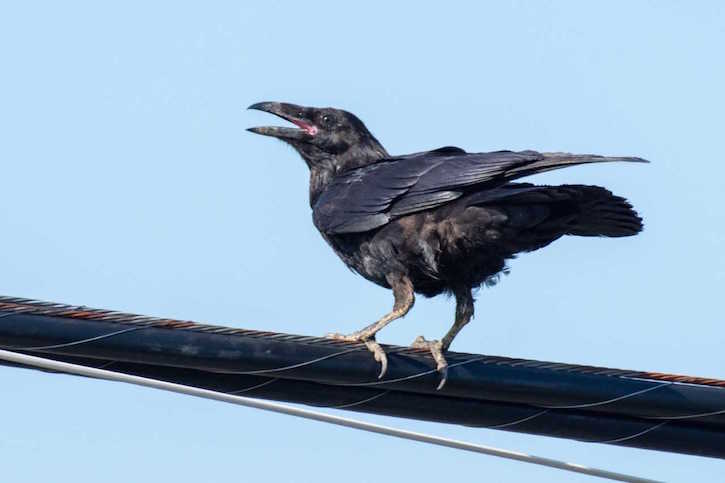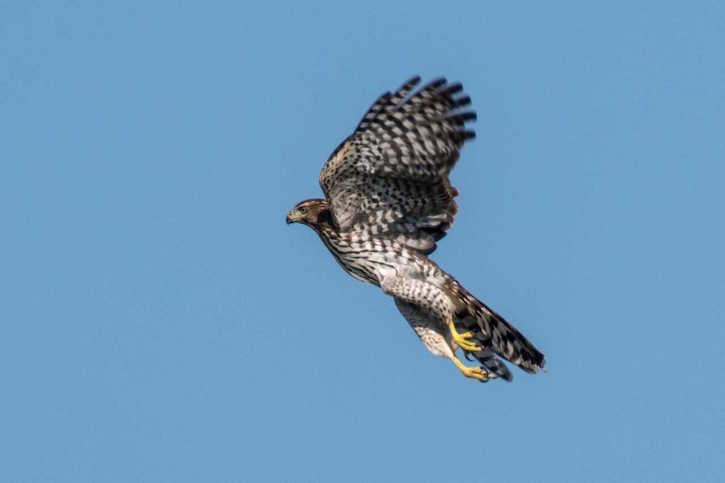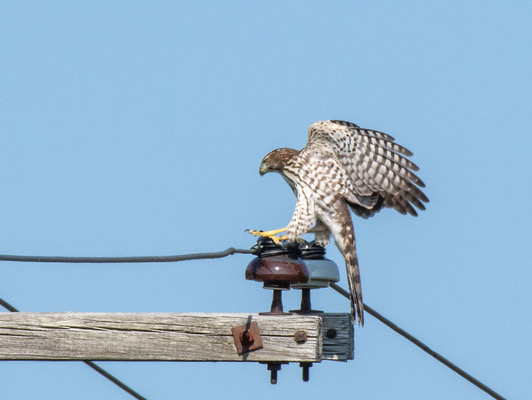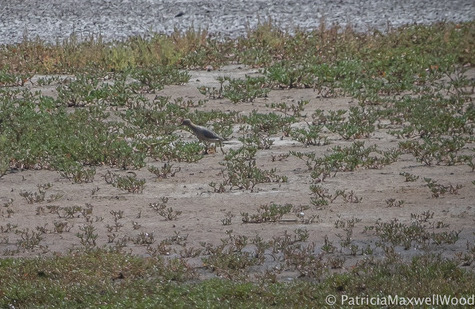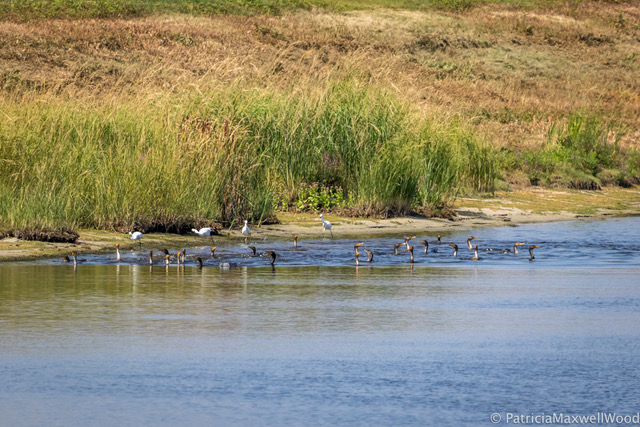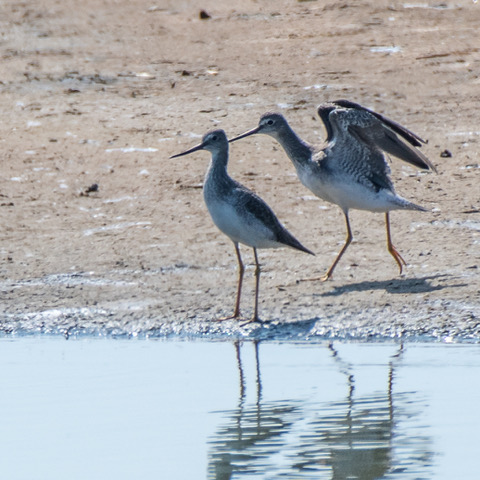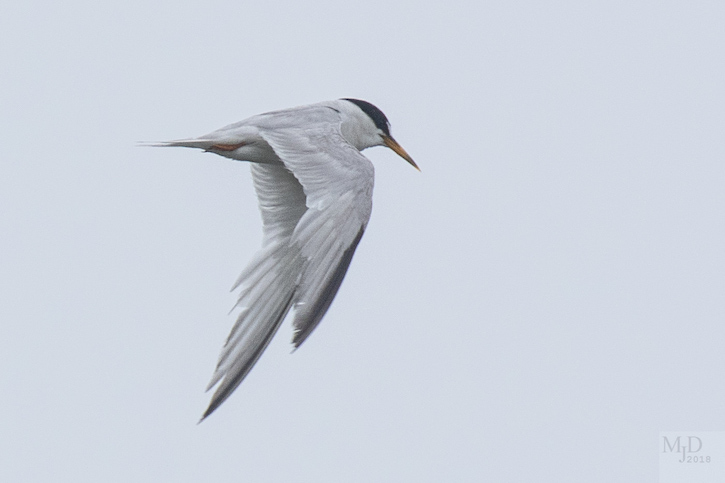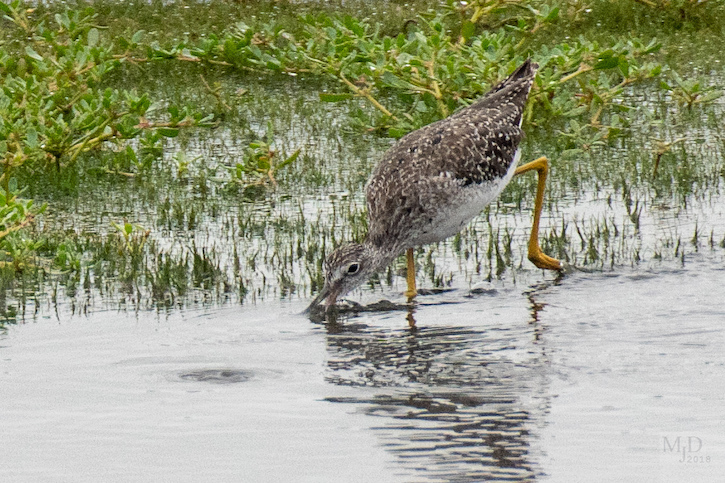This Wednesday, with the tide low, Dave Weaver and I took our big group down the street toward town to get a closer view of the flats. There were hundreds or perhaps thousands of birds, mostly the semipalmated ones, strewn far out on the mud. As is often the case, a group of Black-bellied Plovers stayed together near the edge of the water, while a flock of Bonaparte’s Gulls and Common Terns foraged and rested on the water near them. They were mostly still handsome in alternate plumage. While we spent a short time practicing what identifications one can do with binoculars from such a distance, the inevitable Osprey with a large fish flew across the flats and toward hungry young on the salt marsh.
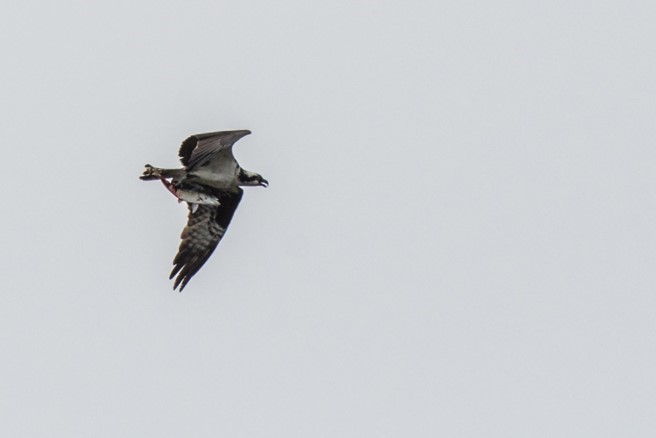
Osprey with fish – Bob Minton
Knowing that a special bird awaited us at the airport, we quickly moved on to find the American Golden-Plover that had been there all day on Tuesday. This bird is still molting out of a majority of its alternate plumage, so was easy to confirm. The runway is again full of Killdeer: 61 were there on Tuesday evening, running around in little clumps or singly, and settling down to roost next to the grass that grows from the cracks in the runway. We accounted for 12 Wednesday morning.

American Golden-Plover – John Linn
We found Parker River Refuge quite different than last week, when lots of shorebirds were found around the tufts of salt marsh grass in the pannes area. This Wednesday, the pannes were flooded, so no margins of mud offered any refuge or foraging opportunities. North Pool, from the overlook, was similarly devoid of shorebirds–not as active as it had been the previous week. While numbers of Tree Swallows had been rising before Wednesday, we did not see very many.
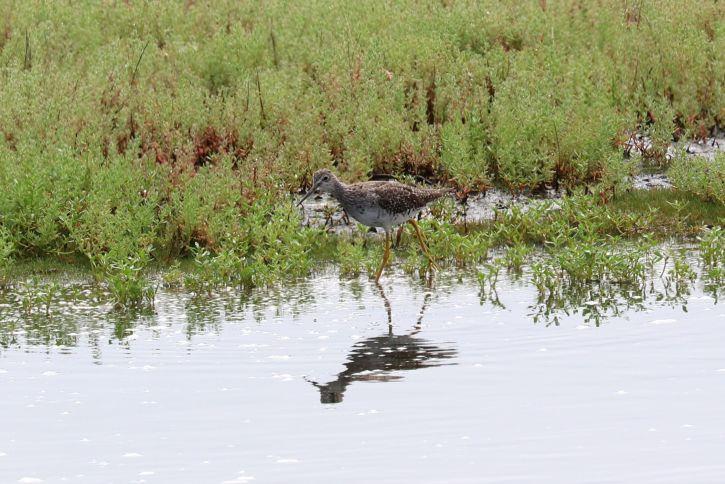
Lesser Yellowlegs – John Linn
At Hellcat, however, our fortunes picked up. We tried splitting up our group to get views from the Bill Forward Blind, but found the pool largely covered with water from heavy rains. One White-rumped Sandpiper foraged in the belly-deep water out with yellowlegs, its posture very erect, more like a Red Knot than a “peep.” Here and there other species showed up. Several roosting Least Terns sat on an island in the pool, and more White-rumped Sandpipers appeared. Two Black-bellied Plovers near the dike spent the entire time we were there marching back and forth right next to each other, one following the other, in a remarkable parade constituting behavior we could not decipher. After a while, the tide rose to a point that birds began leaving the big flats on the Merrimack River. Groups of shorebirds came in — plovers, sandpipers, and dowitchers gradually arrived, so that by the time we left, there was a lively and growing crowd.
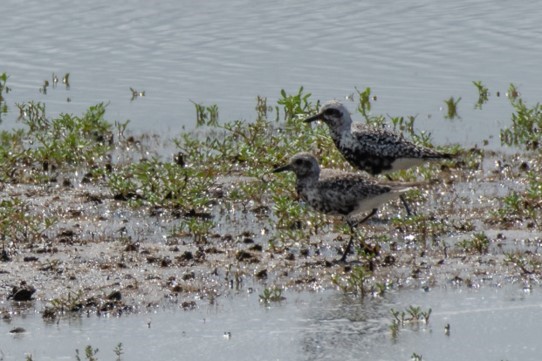
Black-bellied Plovers in synchronous marching behavior – Bob-Minton
On Wednesday, birds started arriving noticeably at Bill Forward Pool when the water level was predicted to be at 0.6 feet in Newburyport, based on the graphs in a tide app that shows the curve of the predicted water level, gives the current predicted level, and allows one to find out what the level is predicted to be at any time in the future. We hope this is leading us toward a rough schedule of the best times to see shorebirds from the boat ramp at Joppa Park or along Water Street. More on that when we have a chance to refine our current predictions, but it looks like the flats are open when the water level predicted at Newburyport is near or just over 1 foot.

American Golden-Plover – David Moon
Our list:
Joppa Flats
Double-crested Cormorant (5)
Great Blue Heron (2)
Turkey Vulture (3) – from Plum Island Airport.
Osprey (1)
Black-bellied Plover (~ 25)
American Golden-Plover (1) – molting adult; PI Airport (thanks, Sue McGrath & Marj Rines!).
Semipalmated Plover (100’s)
Killdeer (12) – PI Airport.
Greater Yellowlegs – common.
Lesser Yellowlegs – common.
Semipalmated Sandpiper – many.
Bonaparte’s Gull (~ 15)
Herring Gull
Great Black-backed Gull
Common Tern – common.
Northern Mockingbird (2) – on Plum Island Turnpike wires.
Plum Island (Parker River NWR)
Canada Goose (~ 12) – Bill Forward Pool.
Gadwall (12) – including hen w/ 7 young at Bill Forward Pool.
Mallard (8)
Wild Turkey (6) – 2 hens, 4 poults; n. refuge entrance.
Double-crested Cormorant (~ 15) – Plum Island Bridge.
Great Egret (~ 8)
Snowy Egret (~ 15) – mostly Bill Forward Pool.
Black-crowned Night-Heron (1) – juv; Bill Forward Pool.
Osprey (2) – Pines platform.
Northern Harrier (1) – female; Bill Forward Pool dike.
Black-bellied Plover (~ 25) – Bill Forward Pool.
Semipalmated Plover (~ 150) – Bill Forward Pool.
Spotted Sandpiper (1) – Bill Forward Pool.
Greater Yellowlegs (8) – Bill Forward Pool& N. Pool from Hellcat dike.
Lesser Yellowlegs (~ 25) – Bill Forward Pool.
Semipalmated Sandpiper (~ 30) – Bill Forward Pool.
Least Sandpiper (1) – small pannes.
White-rumped Sandpiper (4) – Bill Forward Pool.
Short-billed Dowitcher (9) – Bill Forward Pool.
Ring-billed Gull (1) – Bill Forward Pool.
Great Black-backed Gull (1)
Least Tern (8) – Bill Forward Pool.
Common Tern (2)
Mourning Dove (3)
Eastern Kingbird (~ 6)
American Crow (2)
Purple Martin (~ 12) – vicinity of refuge entrance.
Tree Swallow – many.
American Robin (1)
European Starling – many.
Cedar Waxwing (6)
Song Sparrow (1)
Baltimore Oriole (1) – Goodno Woods crossing.
American Goldfinch (1)
House Sparrow
Note – On further review, we decided that it was much more likely that last week’s potential Long-billed Dowitcher was a Hendersoni subspecies of Short-billed Dowitcher, a population that breeds and migrates (more often) in the center of the continent. In photos we could see details like the particularly thick base of the bill, and other subtleties that make SBDO a more likely identification. Dowitchers are hard to discern, unless you hear them!
Note number two – Wednesday Evening, we found the usual species, but in addition, a Stilt Sandpiper, and thanks to Steve Grinley, a Wilson’s Phalarope in Bill Forward Pool!
